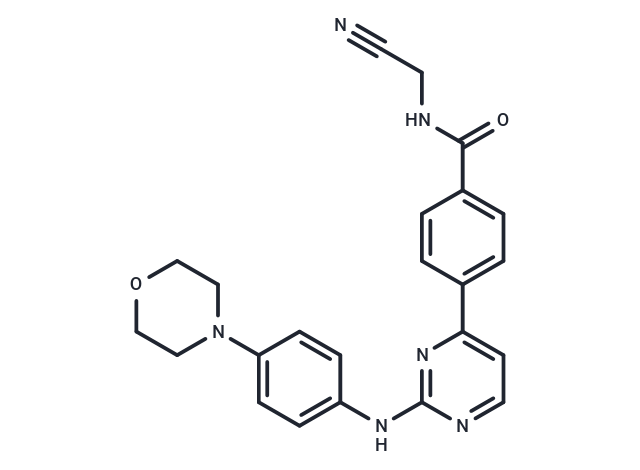Shopping Cart
- Remove All
 Your shopping cart is currently empty
Your shopping cart is currently empty

Momelotinib (LM-1149) is an orally bioavailable small-molecule inhibitor of Janus kinases 1 and 2 (JAK1/2) with IC50 of 11 nM/18 nM. JAK1/2 inhibitor CYT387 competes with JAK1/2 for ATP binding, which may result in inhibition of JAK1/2 activation, inhibition of the JAK-STAT signaling pathway, and so the induction of apoptosis and a reduction of tumor cell proliferation in JAK1/2-expressing tumor cells.

| Pack Size | Price | Availability | Quantity |
|---|---|---|---|
| 1 mg | $32 | In Stock | |
| 2 mg | $45 | In Stock | |
| 5 mg | $74 | In Stock | |
| 10 mg | $96 | In Stock | |
| 25 mg | $169 | In Stock | |
| 50 mg | $272 | In Stock | |
| 100 mg | $428 | In Stock | |
| 200 mg | $657 | In Stock | |
| 1 mL x 10 mM (in DMSO) | $81 | In Stock |
| Description | Momelotinib (LM-1149) is an orally bioavailable small-molecule inhibitor of Janus kinases 1 and 2 (JAK1/2) with IC50 of 11 nM/18 nM. JAK1/2 inhibitor CYT387 competes with JAK1/2 for ATP binding, which may result in inhibition of JAK1/2 activation, inhibition of the JAK-STAT signaling pathway, and so the induction of apoptosis and a reduction of tumor cell proliferation in JAK1/2-expressing tumor cells. |
| Targets&IC50 | JAK1:11 nM, JAK2:18 nM |
| In vitro | In a murine MPN model, CYT387 normalized blood cell density, white blood cell count and spleen size and restored physiological levels of inflammatory cytokines. |
| In vivo | In vitro, CYT387 inhibited IL-3-stimulated proliferation of parental Ba/F3 cells (IC50: 1400 nM). In addition, CYT387 inhibited the growth of red lineage colonies in JAK2V617F-positive PV patients in vitro with similar effect (IC50: 2-4 μM).CYT387 inhibited IGF-1- and IL-6-induced Ras/MAPK and PI3K/AKT signaling. In primary multiple myeloma cells, CYT387 alone or in combination with the MM therapeutic agents bortezomib and melphalan induced apoptosis.CYT387 was 9-fold more selective for JAK1 and JAK2 (IC50: 11 nM and 18 nM) than the JAK3 kinase (IC50: 155 nM).CYT387 also acted on cell lines with constitutive activation of JAK2 or MPL signaling. or MPL signaling cell lines, including Ba/F3-MPLW515L cells (IC50: 200 nM), CHRF-288-11 cells (IC50: 1 nM) and Ba/F3-TEL-JAK2 cells (IC50: 700 nM), and also inhibited cell proliferation. |
| Kinase Assay | Cell-free kinase activity assays: Glutathione-S-transferase (GST)-tagged JAK kinase domains expressed in insect cells are purified before use in a peptide substrate phosphorylation assay. Assays are carried out in 384-well optiplates using an Alphascreen Protein Tyrosine Kinase P100 detection kit and a PerkinElmer Fusion Alpha instrument. |
| Cell Research | Ba/F3 cells expressing JAK2V617F (Ba/F3-JAK2V617F) and MPLW515L (Ba/F3-MPLW515L) mutants, as well as CHRF-288-11 (JAK2T875N) and CMK (JAK3A572V) cells are used. The TEL/JAK2 and TEL/JAK3 fusions are generated and introduced into Ba/F3 murine cells. The TEL/JAK2- or TEL/JAK3-transfected cells are cultured in Dulbecco's modified Eagle's medium (DMEM) containing 10% fetal calf serum (FCS). Ba/F3 wild-type cells are cultured in RPMI containing 10% FCS supplemented with 5 ng/mL murine IL-3. Proliferation is measured using the Alamar Blue assay after incubating for 72 hours at 37 °C with 5% CO2 |
| Alias | LM-1149, CYT387, CYT11387 |
| Molecular Weight | 414.46 |
| Formula | C23H22N6O2 |
| Cas No. | 1056634-68-4 |
| Smiles | O=C(NCC#N)c1ccc(cc1)-c1ccnc(Nc2ccc(cc2)N2CCOCC2)n1 |
| Relative Density. | 1.292 g/cm3 |
| Storage | Powder: -20°C for 3 years | In solvent: -80°C for 1 year | Shipping with blue ice. | |||||||||||||||||||||||||||||||||||
| Solubility Information | Ethanol: < 1 mg/mL (insoluble or slightly soluble) DMSO: 69 mg/mL (166.48 mM), Sonication is recommended. H2O: < 1 mg/mL (insoluble or slightly soluble) | |||||||||||||||||||||||||||||||||||
Solution Preparation Table | ||||||||||||||||||||||||||||||||||||
DMSO
| ||||||||||||||||||||||||||||||||||||

Copyright © 2015-2025 TargetMol Chemicals Inc. All Rights Reserved.